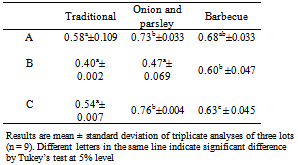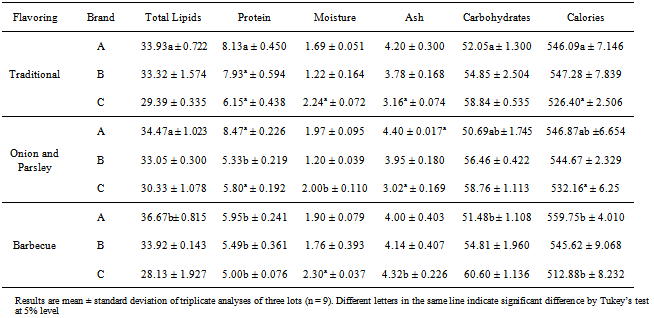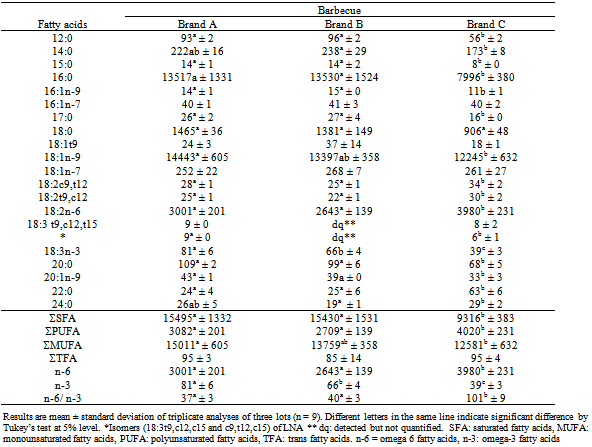-
Paper Information
- Next Paper
- Previous Paper
- Paper Submission
-
Journal Information
- About This Journal
- Editorial Board
- Current Issue
- Archive
- Author Guidelines
- Contact Us
Food and Public Health
p-ISSN: 2162-9412 e-ISSN: 2162-8440
2012; 2(5): 153-158
doi: 10.5923/j.fph.20120205.06
Influence of the Addition of Flavoring on the Sodium Content of Fried Potato Chips and the Fatty Acid Profile
Paula Fernandes Montanher 1, Luana Nascimento de Paula 2, Fabio Augusto Garcia Coró 2, Lucia Felicidade Dias 2, Mayka Reghiany Pedrão 2, Nilson Evelazio de Souza 2
1Department of Chemistry, State University of Maringá, Av. Colombo, 5790, CEP 87020-900, Paraná State, Brazil
2Federal Technologic University of Parana, Av. Dos Pioneiros, 3131, CEP 86036-370, Londrina, Parana State, Brazil
Correspondence to: Nilson Evelazio de Souza , Federal Technologic University of Parana, Av. Dos Pioneiros, 3131, CEP 86036-370, Londrina, Parana State, Brazil.
| Email: |
 |
Copyright © 2012 Scientific & Academic Publishing. All Rights Reserved.
The influence of the addition of flavorings on the sodium content and the fatty acid profile of fried potato chips, particularly of trans fatty acids and the centesimal composition, of fried potato chips was investigated. Three brands of two types of flavored fried potato chips (onion plus parsley and barbecue) and the traditional product were assessed. An increase in the sodium content was observed in all flavored products of all brands. Among the flavored products, brand B had the lowest values of sodium (0.40, 0.47 and 0.60 g 100 g-1 of the unflavored product, onion and parsley, and barbecue, respectively). The total lipid (TL) values were high, ranging from 28 to 35%. All flavors of brand C had the lowest TL content. The fatty acids in the greatest amounts were palmitic acid (16:0), stearic acid (18:0), and oleic acid (18:2n-6). The amounts of trans fatty acids (TFA) were low and under 0.2 g per portion, the limit set by the regulation in force. Among the samples evaluated, brand C had the highest TFA contents, 92, 157, and 95 mg 100 g-1 of food in the traditional, onion and parsley, and barbecue flavorings, respectively.
Keywords: Fried Potato Chips, Trans Fatty Acids, Flavorings, Sodium
Article Outline
1. Introduction
- One of the effects of globalization is undoubtedly new eating habits. More and more often industries are investing in ready or easy-to-prepare foods, to which significant amounts of sugar, salt, fat, food dyes, and flavorings are frequently added[1].Eating Fried potato chips, one of the ready foods with great acceptability, is one of these new eating habits. Two of the negative effects of the excessive consumption of fried potato chips are their high fat and sodium contents.Sodium is the main cation in the extracellular fluid and one of the main minerals in the plasma. Its function is mainly modulating the liquid exchange between several body compartments. It is also essential for the maintenance of the osmotic pressure of the blood, plasma and fluids. However, excessive consumption of sodium is related to the development of arterial hypertension, one of the major diseases of modern society[2, 3].Excessive amounts of sodium are used by the food industry, very often to set off the loss of flavor due to the reduction of the fat content[4].Besides the salt added to fried potato chips, flavorings may also be used to add flavor and sharpen and/or modify the flavor and aroma of foods. Besides flavor enhancers, such as monosodium glutamate, an amino acid naturally present in foods rich in proteins, and one of the main components responsible for the Umami flavor sensation, which is considered the fifth flavour, are also largely used[5].While salt and aromas are intentionally added to the product, the high fat contents of fried potato chips result from the frying food processing. This processing involves simultaneous heat and mass transfer. The medium used in the heat transfer (oil or fat) becomes part of the product. The frying conditions determine the distribution of oil, the texture, and the characteristic final flavor of the food[6].The oils and fats used in the frying process can undergo degradation reactions associated with the food moisture (hydrolytic reactions), the presence of oxygen (oxidative reactions), and heat (thermal reactions). These reactions lead to the formation of various products, many of which have deleterious effects on human health, such as the trans fatty acids (TFA)[7].The objective of this study was to investigate the fatty acid composition of fried potato chips and the influence of the addition of flavorings on their sodium content.
2. Materials and Methods
- Three brands of potato chip were analyzed. Two, labeled A and C, are sold worldwide, and B is a Brazilian brand. The samples were purchased in local supermarkets between November 2009 and March 2010. Three flavors of each brand were analyzed in three lots with three units of each flavor. The three units of each lot were pooled and analyzed in triplicate. The packages of brands A and B had 100 g and brand C had 40 g.The total lipids (TL) were extracted following the method published by Bligh and Dyer[8] and the fatty acid methyl esters were prepared by the Hartman and Lago method[9].The fatty acids methyl ester were analyzed in gas chromatograph CP-3380 (Varian, USA) equipped with a flame ionization detection (FID) and a 100% cyanopropyl bonded silica capillary column CP-7420 (100 m, 0.25 mm i.d. and 0.25 μm film thickness) (Varian, USA). The gas flow rates used were 1.4 mL.min-1 for the carrier gas (H2); 30 mL.min-1 for the auxiliary gas (N2), and 30 and 300 mL.min-1 for H2 and the flame synthetic air, respectively. The sample split rate was 1/80. The injector and detector temperatures were 240℃. The column temperature was kept at 197℃ for 23 min, raised to 225℃ at 20℃ min-1 and held for 15 min.
- The column conditions were optimized by Martin et al.[10] for the separation of trans fatty acid methyl esters.The injections of 2-μL volumes were performed in duplicate. The peak areas were determined with the software Workstation version 5.0 (Varian).The fatty acid methyl esters were identified by comparison with the retention time of standards from Sigma (USA) and by spiking with standards for verification of the increase in the peak areas.The fatty acid methyl esters were quantified in relation to the internal standard, methyl tricosanoate (23:0) from Sigma (USA). The quantities of the fatty acids in the samples were calculated using the equation proposed by Joseph and Ackman[11].
- Mx = Mass of fatty acid X in mg g-1 of lipids.MP = Mass of the internal standard in milligrams.MA = Mass of the sample in grams.AX = Area of fatty acid X.AP = Area of the internal standard.FCT = Theoretical correction factor.FCEA = Factor of conversion of fatty acid methyl esters.The moisture, ash, and crude protein content of the samples were determined by the AOAC method[12].The samples were opened for the analysis of sodium by dry path and the readings were performed with a flame photometer from Analyzer®.
 where:
where:
2.1. Statistical analysis
- The results were submitted to variance analysis (ANOVA) at 5% level of significance using Tukey's test in the software Statistica, version 7.0[13].
3. Results and Discussion
- The contents of sodium found in fried potato chips are given in Table 1. It ranged from 0.40 to 0.76 g per 100 g of product. All three brands presented significant differences (P<0.05) in sodium contents for the addition of flavorings.The increase in the amount of sodium in the flavored fried potato chips is related to the addition of flavor enhancers (monosodium glutamate, disodium inosinate, and disodium guanylate), which results in an increase in the salinity of the products[5]. The Brazilian regulations allow the use of food flavor enhancers[14] and set no limit to the amounts added. Amounts are added according to the flavor wanted.
- Taking into consideration the WHO recommended values, the consumption of 100 g of the Brand C product with onion plus parsley flavoring (0.76g 100 g-1) results in an intake very close to the daily limit for hypertensive individuals.
- Table 2 gives the centesimal composition results of fried potato chips. The high amounts of total lipids, ranging from 28 to 37 g 100 g-1 of product, stand out.
- The results of the quantification of fatty acids in fried potato chips are given in Table 3, 4 and 5. The statistical analyses of the lots of all samples show a significant difference (p<0.05) in most fatty acids, which indicates the non homogeneity between the lots and standard deviation.Various factors may lead to the formation of trans fatty acids, including high processing temperature during the oil deodorization and long processing time and high temperature during food frying[16, 17].According to the product nutritional labels of all flavored fried potato chips investigated, they are irradiated for improved food conservation. Research indicates that irradiation may also lead to the formation of trans fatty acids[18].
- The nutritional labels of the products investigated informed zero contents of trans fatty acids. Foods are considered to have zero trans fatty acids when their content is lower or equal to 0.2 g per helping[19].Thus, the information in the food labels of all products was confirmed, as none presented more than 0.2 g per portion of 25 g (label portion size).The addition of flavorings to fried potato chips was found to be associated with the sodium content, which was high in all the investigated brands.The total trans fatty acid contents of the three brands of fried potato chips were low and within the regulation values. A trans fatty acid content reduction was also observed over the years, with the consequent improvement of the product. However, due to the large amounts of saturated fatty acids and total lipids in fried potato chips, moderation in their consumption is advisable.
- The replacement of hydrogenated vegetable fat resulted in a decrease in trans fatty acids, as demonstrated by the samples analyzed; however, it also increased the saturated fatty acid content.
- The n-6/n-3 ratio of all samples was above the literature recommendation, which ranges from 2:1 to 3:1[20] and 5:1 to 10:1[21]. The current ratio ranged from 39 to 100, with brand C presenting the highest values for all flavors.
|
|
|
|
|
ACKNOWLEDGEMENTS
- The authors are grateful to CAPES and CNPq for the financial support.
 Abstract
Abstract Reference
Reference Full-Text PDF
Full-Text PDF Full-Text HTML
Full-Text HTML



